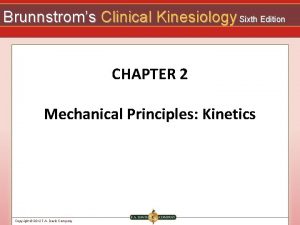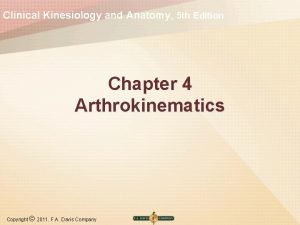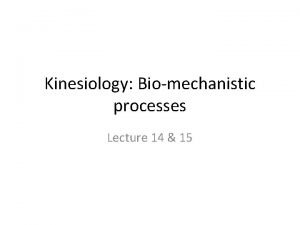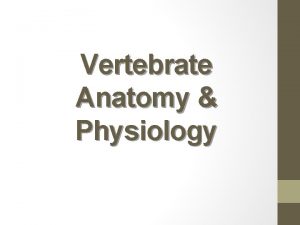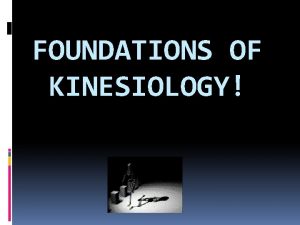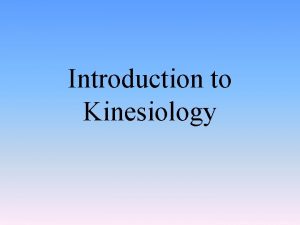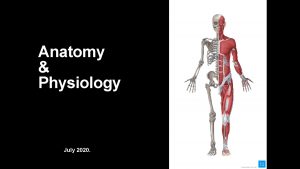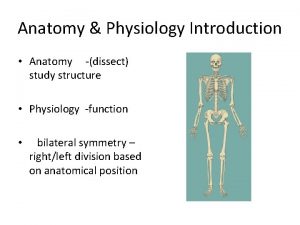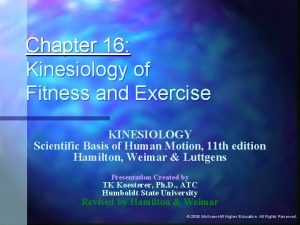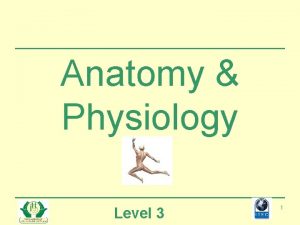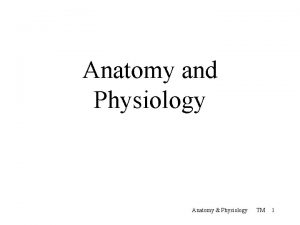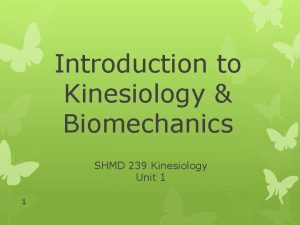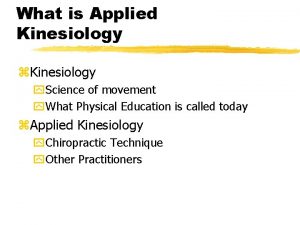Kinesiology The study of the anatomy physiology and





































- Slides: 37


Kinesiology The study of the anatomy, physiology, and mechanics of body movement, especially in humans Kinesiology, also known as human kinetics, is the scientific study of human movement. Kinesiology addresses physiological and mechanical mechanisms.

OBJECTIVE To apply the mechanical principles on human body movements. At the end of this lecture you will be able to understand 1. Force. 2. Composition of force. 3. What is point of application of force. 4. Resolution of forces. 5. Principles of compounding forces. 6. Tension.

FORCE “Force is an agent which alters the state of rest of a body or its uniform motion in a straight line. ”

Composition of force 1) Direction of force : represented by the direction of the arrow. 2) Magnitude of force : represented by the length of the arrow. 3) Point of application: by tail of arrow

Compounding of forces 1. Two forces acting in same direction and at a common point? 2. Two equal forces acting at a common point and in opposite directions? 3. Two unequal forces acting at a common point and in opposite direction?

Tension “System of forces tending to separate parts of the body combined with equal and opposite forces which hold the parts together. ” Unit: NEWTON

MECHANICS OF POSITION 1. 2. 3. 4. 5. 6. GRAVITY CENTRE OF GRAVITY LINE OF GRAVITY BASE EQILIBRIUM FIXATION AND STABILIZATION

GRAVITY “Gravity is the force by which all bodies are attracted to earth. ” NEWTON’S EXPLANATION: Force of attraction existed between all material objects and the magnitude of attraction was 1. Directly proportional to MASS of each body 2. Inversely proportional to SQUARE DISTANCE between the bodies

Direction of gravitational attraction of earth? “towards the centre of earth and acts continuously”

Force of gravity on human body 1. What will happen if the gravity is un opposed? 2. Who opposes the force of gravity? 3. What if the opposing force is greater then force of gravity?

If un opposed the person will fall to the ground Effects of the gravity can be counterbalanced when a force equal and opposite to it is employed e. g. a) support of plinth b) buoyancy of water c) isometric muscle contraction

If opposing force is greater then gravity Movement will occur in the direction of that force Examples: Heel standing a) Can be raised from ground by the contraction of calf muscles. (force greater then gravity). a) As long as the force remains equal to gravity. b) Heel will be lowered to ground if m/s relaxes.

Anti-gravity muscle In erect position the balance is maintained by the integrated action of many m/s. Predominantly extensors. True relaxation can only occur under conditions in which the m/s are no longer required to work against the effects of gravity.

CENTER OF GRAVITY Of a rigid body is the point through which the earth’s attraction effectively acts whatever the position of the body i. e. the point through which line of action of weight acts. Examples: I. Uniform rod: exactly half-way along its length. II. Irregular body: Plumb line method Centre of gravity may lie outside the body e. g. ring

COG of human body In anatomical position. Vicinity of 2 nd sacral vertebrae. NOTE: Its position may vary according to the anatomical structure of the individual. Reason: greater amount of weight they carry in upper half of the body.

IMPORTANT: Direct support at the COG of human body is not possible and its exact position is merely of interest in assessing the distance between COG and point of support. Location of gravity will vary with the different postures assumed by the body.

LINE OF GRAVITY Line of gravity is an imaginary line which passes through the centre of gravity. FUNDAMENTAL STANDING POSITION: LOG passes through 1. vertex 2. 2 nd sacral vertebrae 3. point between the feet (level with the transverse tarsal joints).

NOTE: Relationship of the body structures to the LOG is subject to considerable variation in accordance with individual differences in posture and anatomical structure.


On average when posture is good LOG passes through a. b. c. d. Mid-cervical vertebrae Mid-lumber vertebrae In front of thoracic vertebrae. External ear and point of shoulders are in same frontal plane and lie lateral to the LOG. e. Central axis of knee and ankle joint lie poster-lateral

BASE Applied to a rigid body, is the area by which it is supported. Examples: Cube : face on which it rests. Chair : area bounded by the lines joining the legs. Lying : posterior aspect of the whole body forms the base. Stride standing : area as wide as the feet.


Equilibrium “ when the forces acting upon the body are perfectly balanced and the body remains at rest or uniform motion. ”

Types of equilibrium There are three types of equilibrium 1. Stable equilibrium 2. Unstable equilibrium 3. Neutral equilibrium

Stable equilibrium If the forces acting upon the body at rest tend to restore it to its original position after it has been displaced. Important: The condition of equilibrium is most stable when COG is as low as possible LOG falls near the centre of extensive base.

Unstable equilibrium If a body is given an initial displacement and the forces acting upon it increase the initial displacement, however small the latter may be , the body is said to be in unstable equilibrium. Reason: very small displacement cause the line of gravity to fall outside the base. Important : COG as high as possible Small base

Most unstable when COG is raised. LOG falls near the margin of the base.

Neutral equilibrium If in spite of displacement of a body , the height and position of COG remains same in relation to the base. e. g. ball moves on a plane surface.


Stability of human body Greatest in lying position Becomes progressively less stable as the COG is raised and the base is reduced e. g. sitting and standing positions.

Fixation and stabilization Fixation : state of immobility. Stabilization: relative immobility. Types of fixation: Active fixation. Passive fixation.

Active fixation : obtained by the co contraction of muscles. Passive fixation : By manual or mechanical. a) manual pressure. b) straps. c) sandbags.

Importance of fixation Preventing movements in joints. e. g. maintaining posture or for localizing movement to specific joint. Improve efficiency of muscles by fixing their origin. Localize movement in performance of passive movement.

Stabilization: Suitable background for activity by stabilization of areas which are not required to take part in movement. To increase its efficiency or to maintain balance.

Fractures, joint injuries and disease necessitating long-term immobility will require?

Fixation by mechanical means 1. 2. 3. Splint age Balanced traction Operative measures e. g. bone grafting or plating.
 Brunnstrom's clinical kinesiology 6th edition
Brunnstrom's clinical kinesiology 6th edition Clinical kinesiology and anatomy 6th edition
Clinical kinesiology and anatomy 6th edition Upper respiratory tract
Upper respiratory tract Tattoo anatomy and physiology
Tattoo anatomy and physiology Anatomy science olympiad
Anatomy science olympiad Incomplete flower
Incomplete flower Anatomy and physiology bone
Anatomy and physiology bone Anatomy of an ulcer
Anatomy of an ulcer Liver anatomy
Liver anatomy Podbřišek
Podbřišek Iliac regions
Iliac regions Blood in anatomy and physiology
Blood in anatomy and physiology The central sulcus divides which two lobes? (figure 14-13)
The central sulcus divides which two lobes? (figure 14-13) Endomysium
Endomysium Http://anatomy and physiology
Http://anatomy and physiology Waistline
Waistline Appendix anatomy and physiology
Appendix anatomy and physiology Aohs foundations of anatomy and physiology 1
Aohs foundations of anatomy and physiology 1 Aohs foundations of anatomy and physiology 1
Aohs foundations of anatomy and physiology 1 Anatomical planes
Anatomical planes Anatomy and physiology chapter 8 special senses
Anatomy and physiology chapter 8 special senses Chapter 13 anatomy and physiology of pregnancy
Chapter 13 anatomy and physiology of pregnancy Unit 26 self evaluation answers
Unit 26 self evaluation answers Science olympiad forensics cheat sheet
Science olympiad forensics cheat sheet Chapter 2 basic chemistry anatomy and physiology
Chapter 2 basic chemistry anatomy and physiology Liver anatomy and physiology ppt
Liver anatomy and physiology ppt Anatomy and physiology of pancreas in diabetes
Anatomy and physiology of pancreas in diabetes Heat and cold
Heat and cold Art labeling activity: figure 14.1 (3 of 3)
Art labeling activity: figure 14.1 (3 of 3) Chapter 10 blood anatomy and physiology
Chapter 10 blood anatomy and physiology Aohs foundations of anatomy and physiology 1
Aohs foundations of anatomy and physiology 1 Aohs foundations of anatomy and physiology 1
Aohs foundations of anatomy and physiology 1 What produces bile
What produces bile Anatomy and physiology chapter 15
Anatomy and physiology chapter 15 Cornell notes for anatomy and physiology
Cornell notes for anatomy and physiology Anatomy and physiology edition 9
Anatomy and physiology edition 9 Necessary life functions anatomy and physiology
Necessary life functions anatomy and physiology Holes anatomy and physiology chapter 1
Holes anatomy and physiology chapter 1
